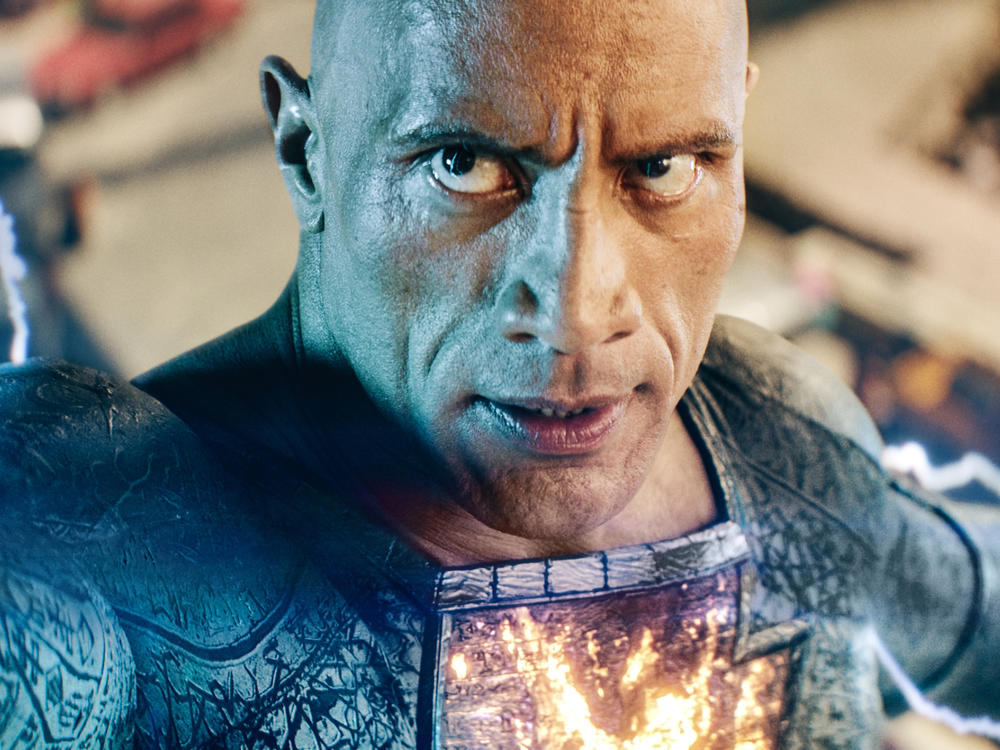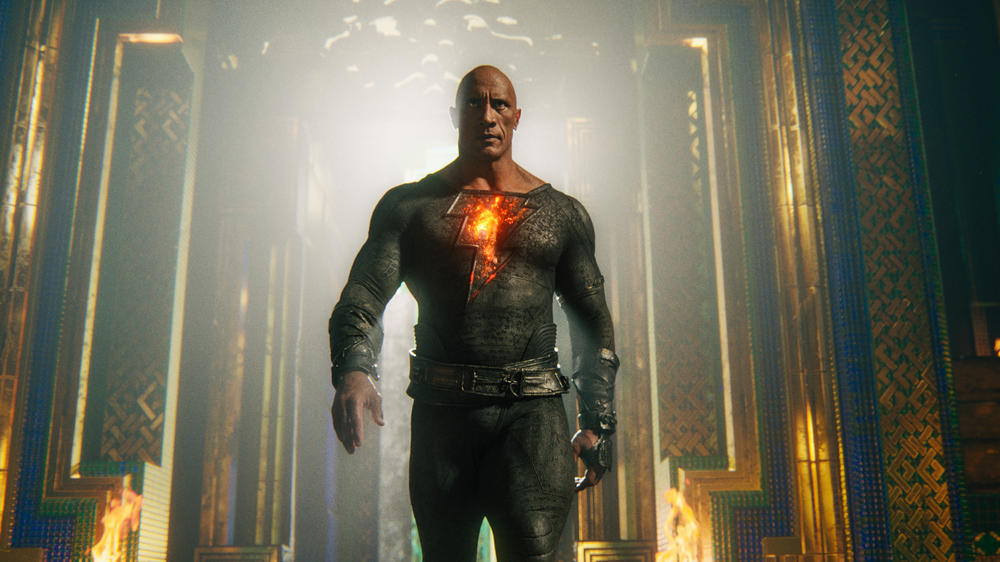Section Branding
Header Content
In 'Black Adam,' a lightning-based champion can't hold a charge
Primary Content
Black Adam is what happens when you build a movie from the outside in — when you start with the visuals and figure everything else will just fall into place.
More to the point: Black Adam doesn't work. To understand why, it helps to know where the character comes from.
In the early 2000s, writers Geoff Johns and David S. Goyer — with art by Stephen Sadowski and many others — introduced to the comics pages a new version of Black Adam. The character had been around since the 1940s as a supervillain who dogged the family of superheroes that, like him, had been given powers by the wizard Shazam. As such, he came factory-installed with the basic supervillain-threats package: I'll destroy you, I'll rule the world, etc.
Their new Black Adam, however, was a statesman in spandex, ruler of the fictional nation of Kandhaq. He was haughty, superior, imperious, humorless. They were careful never to depict him doing anything so prosaic as walking, or even standing. No — whenever you saw him, he hovered about a foot above the floor, peering down his aquiline nose at those (literally and figuratively!) beneath him. It was a power move, obviously — and it made for a great visual. Not for nothing.
When what the Rock is cooking is under-seasoned
From the moment he was first revamped in the comics, fan sites lit up with posts dreamcasting Dwayne "The Rock" Johnson as Black Adam. In their defense, there was a strong resemblance. And as this is superhero comics we're talking about, keep in mind that the essential appeal of any character is partly — let's be real, largely — visual. Particularly for readers of comics who start young, it's a hero or villain's look — their color palette, costume design, logo, and their sheer physicality as rendered across splash pages and bursting out of panel grids — that first pulls you in, and will likely retain its visceral power over you for the rest of your life.
So those fans posting their composite renderings of Black Adam's costume crudely (and sometimes not-so-crudely) Photoshopped over Johnson's superhero-ready physique were responding to something real — but that something was strictly visual. It ignored all of the dutiful work that comics writers and artists had devoted to defining the character's newly made-over vibe as a kind of diet Doctor Doom. (Doctor Vague Dread? Doctor Outlook Not So Good? Doctor Don't Count Your Chickens?)
Among the many fans of the comics' Black Adam who didn't get this particular memo, if we're to simply judge by the evidence available onscreen in Black Adam, is Dwayne Johnson himself.
Because while the actor played the heel back in his wrestling days, he's spent his retirement from the ring assiduously cultivating a charming, wisecracking, everyone's-older-brother persona, both on and off the screen. His is a charismatic presence that flatly, emphatically and very intentionally exists to dispel notions like "haughty," "imperious" and especially "humorless."
It's easy to imagine the big lug reading a comic depicting Black Adam as an all-powerful badass who slaughters hundreds of bad guys and thinking: That'd be cool to play. And then, after checking his socials, going even further than that: And people want to see me play it!
But his performance in director Jaume Collet-Serra's middling, muddled foray into the DCU keeps fighting against itself — and losing. The actor's dogged attempt to play aloof and imperious effectively quashes his natural, movie-star charisma — his ability to connect to audiences — and shuts him down completely. As a result, his Adam comes across as simply dour. Distant. Ponderous. Persnickety, even.
Hey Mr. Producer, I'm talking to you, sir
Perhaps he thinks he's serving Clint Eastwood's stoic Man With No Name? Certainly the film itself explicitly and repeatedly references that character. The difference, which turns out to be an all-important one, lies in the two actors' respective approaches to stardom.
Eastwood never particularly cared what we thought of him as a person. Johnson, however, has always displayed an innate yet carefully cultivated sense of what he believes his audience wants from him, and a baseline desire to move through the world as Four-Quadrant Appeal made flesh. You can feel that brand-awareness, that abiding cautiousness, leaking out of Johnson every moment he spends onscreen here.
That the star is also a producer of Black Adam will be lost on no one, as it keeps manifesting in ways small and large.
Small first: In the comics, Black Adam sports a Dracula-esque widow's peak and pointy little elf-ears. Both of those attributes got nixed — in a very early production meeting, no doubt.
Again and again in the film, physical representations of other, much better-known DC Comics characters — posters, action figures, etc. — get crushed or shredded or pulverized into a fine dust. It feels playful at first — a shot across the bow! — but then, somewhere after the fifth occurrence, it becomes something else.
More centrally, we have Johnson's insistence that Black Adam's story merited its own film, and should not get shunted into a Shazam! sequel, as was originally planned. This despite the fact that the two characters share the same origin, power set and visual iconography. What are we to make of the fact that Zachary Levi's Shazam! character, a powerful flying guy with lightning powers, doesn't even rate a mention in a film whose central plot finds Amanda Waller (Viola Davis, again) scrambling to find heroes capable of going up against...a powerful flying guy with lightning powers?
If there's a difference between being a producer and convincing a major studio to bankroll your vanity project, Black Adam doesn't argue strongly for it.
Going back for seconds, and thirds, and fourths
It seems both obvious and inevitable to note that, this many years into superhero cinema's ascendancy, novelty comes at a premium.
Even so, Black Adam seems perfectly content to pick over the wilted remains of the superhero-movie salad bar. Its wry, goateed wizard Dr. Fate (Pierce Brosnan) plays like warmed-over wry, goateed wizard Dr. Strange. Its gee-shucks, hero-worshipping giant Atom-Smasher (Noah Centineo) can't help but remind us of gee-shucks, hero-worshipping giant Ant-Man. Its magical element Eternium feels like something scribbled on the whiteboard at the naming session where they brainstormed Vibranium. And the nerdy kid who eagerly advises Black Adam about his powers and catchphrases (Bodhi Sabongui) owes so much to the nerdy kid who eagerly advised Zachary Levi's character about his powers and catchphrases that it's gotta be an intentional attempt at parallelism. Right?
What is arguably new — new-ish, anyway — about Black Adam is how matter-of-factly it positioning at its center an all-powerful anti-hero who kills without remorse.
But even this gets in the way of the film's storytelling. We kick off with the Kandhaqi freedom-fighter Arianna (Sarah Shahi) unwittingly awakening Black Adam from his millennia-long sleep and, equally unwittingly, leading many, many, many generic bad guys to his location. Black Adam unceremoniously proceeds to slaughter them in a set-piece marked by Zack Snyder-esque camera flourishes — but in the aftermath, as he hovers over a field strewn with dismembered corpses, you start wondering where the film can go from there. How does it escalate? How does it hope to increase the tension?
For a while, Black Adam simply opts not to bother. Instead, it just keeps throwing more generic bad guys into the po-faced, levitating sausage grinder that is Johnson's character. When the Justice Society arrives, with its more powerful opponents, it's reasonable to hope that they'd pose something of a challenge. But no, not really — he still kicks their asses in a series of hero-on-hero fight scenes. It just takes him a little longer.
You'd think, in a movie that featured so many of the kind of super-powered confrontations that most films like this shunt to the third act, we'd be mercifully spared the climactic clash in which the hero fights an evil version of themselves.
Don't hold your breath.
When CGI catches up to comics artists
But back to the Justice Society — there's Brosnan's Dr. Fate, Centineo's Atom-Smasher, plus Aldis Hodge's Hawkman and Quintessa Swindell's Cyclone. Don't worry, you haven't missed the movie that introduced any of them before — this isn't the MCU, after all, where characters get a trot around the track on their own before getting dragooned into a team. In DC, everyone hits the ground running at the same time.
Consequently, the film asks us to invest far more emotional weight in the Dr. Fate/Hawkman friendship than Brosnan and Hodge manage to generate in their scant minutes of screen time together.
But at least they look great, which is no small feat. Growing up reading Dr. Fate comics (yes, I was the one!) I've always loved the bold simplicity of his blue-and-gold outfit — whenever he dons the helm that obscures his face, he could pass for the mascot of University of Michigan's fencing team. And while Hawkman's costume always looks great on paper, there's a nagging goofiness that's crept into his few previous live-action forays.
Think about it: In the comics, you've got a guy hovering in the air with wings dramatically extended. Awesome! Iconic!
But in live-action, the only way that same guy stays airborne is by...flapping. And flapping. And flapping. It's much less striking. It's vaguely uncomfortable to look at, frankly.
This Hawkman works, though. So well that you hardly even notice the flapping.
The hero Cyclone isn't given much to do, but what little she does, she does colorfully. As she generates and controls the wind, she transforms into a multi-hued blur — until, that is, director Collet-Serra ramps down the camera speed, and we get a glamour shot that looks like a Sears Portrait Studio photographer instructed her to poke her head through a bed of rainbow cotton candy.
Keep it simple, for the shareholders
Early on, you'd be forgiven for thinking that Black Adam aims to engage with ideas that, historically, PG-13 studio superhero movies studiously avoid: the brutal legacy of imperialism and colonization, for example. The inadequacy of individual action – even superheroic action — within systems built to oppress. For a thrilling moment, even the most essential tenet of superheroism — the whole notion of putting one's faith in a single individual, any individual, instead of taking collective action — seems like it might be on the table. But in the end these ideas, and others, get only gestured toward, never seriously engaged with.
Most mystifying is the film's decision to depict Kandhaq as a country under the thumb of a white occupying force, only to then primly insist that the true enemy here is a homegrown would-be tyrant. It's a dodge, and it's put there intentionally to assuage, to reassure, to smooth any feathers that might get ruffled by the blandest suggestion of Western culpability in the oppression of even a fictional people.
It's just one more of this film's many frustrating aspects, but it's rooted, like all the rest of them, in the overcautious, risk-avoidant hollowness of its central performance.
Copyright 2022 NPR. To see more, visit https://www.npr.org.
Bottom Content


